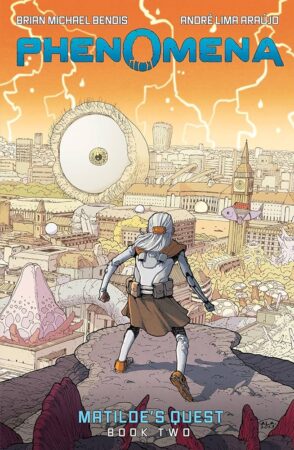This Must Be the Place by Michael Sweater
This book is one of the few records that a strip called Please Keep Warm ever existed. Well, there are launch announcements and excerpts elsewhere, but the actual GoComics strip has fallen into the memory hole, never to be seen again.
The strip launched in February of 2017; this book came out in the summer of 2017. When did the strip end? I have no idea. So this is probably the beginning, but it’s unclear how much more more might be lurking in creator Michael Sweater’s files, if anything. So This Must Be the Place declares itself to be A “Please Keep Warm” collection, but my suspicions are that it’s the only one.
Anyway: This Must Be the Place starts with a five-page page-formatted comic – the bit excerpted in Vice – and then turns into a four-tier layout, with each tier (I think) an individual strip, for about eighty pages, and then has a few more page-formatted short stories at the end. (My assumption is that those are from anthologies, either during or after the life of the strip.) The whole thing runs 108 pages of comics, and it’s all consistent and coherent – all the same kind of thing. (That’s not always the case with new strips; creators often write their way into things and experiment, particularly if they’re shifting formats like Warm does.)
Four people live in a house together: the book starts out by centering Clover, who is a kid of unspecified years – probably elementary school, maybe even younger. She lives with her Uncle Stan, who is trying to write a novel; Catman, who I think has some sort of office job and is low-key the Krameresque goofball of the group; and Flower, who doesn’t seem to have any sort of central deal other than the fact that her sleeves are longer than her arms. Stan, Catman, and Flower all seem to be mid-20s, pseudo-slackers, the kind of characters who would probably be stoners if this strip appeared somewhere even slightly more counterculture than GoComics. Clover is mostly the center, and has the typical strip-comic kid’s random enthusiasms, energy, and big body language while her enthusiasms (death metal, skateboarding) are more “adult” coded.
It comes off as a slightly “alternative” take on a standard family comic strip – found family rather than nuclear, all that jazz – and the humor oscillates between those two poles. At it’s best, it finds a sweet spot in the middle, as with Clover’s death metal obsession – she loves it like a kid would, but also makes a demo and worries about promo like an professional. Each of the other characters has similar quirks that I’m leaving out here, including several members of the secondary cast who don’t live in this house.
It’s mostly “nice” with eruptions of “cool,” I guess – it might not have run that long because it is trying to be both of those things regularly, and the two audiences might not be hugely compatible. But Please Keep Warm makes its own consistent vibe, has fun with the way it tells stories, features amusing characters, and does pretty much what it sets out to do. That is all just fine with me.
Reposted from The Antick Musings of G.B.H. Hornswoggler, Gent.




















